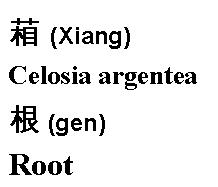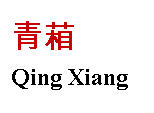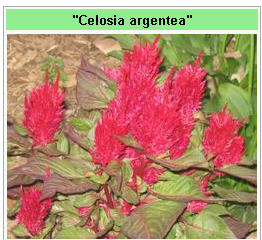
|
Subject:The root of Celosia Argentea (Plumed Cockscomb or Wild Cockscomb)
Posted By: Bill Wed, Oct 03, 2007
Wow, Jessee:
You have some of the most interesting objects posted here in the forum and yet they are the most difficult to decipher.
I must kowtow to Mike. He really did a great job and his vast knowledge in both Chinese language and Chinese cultures is simply amazing. I am still learning from him. I would not have any idea what this piece is. I have never seen anything like it. So although the penmanship of the two words here are not that artistic (I can probably do better and Mike much much better), I believe it is because whoever carved them was probably not a scholar. I agree with him that this piece is not modern because I do not believe any Chineses who are still alive today will know what it is. (unless they are herbal doctors or pharmacists.)
The two Chinese characters from top to bottom (or from right to left) are exactly as Mike described:
Xiang Gen (see Characters as listed on Pic 1)
The word "Xiang" I believe is written correctly and in this case it does mean "Cleosia Argentea" as Mike has correctly translated.
The word (or character) "Xiang" is actually the abbreviation for "Qing Xiang" (green xiang)(see pic 2) which means the same Chinese herb - Closia Argentea.
The word "Gen" is just like Mike translated it and it means "root".
Therefore the two words, "Xiang Gen" is indeed the root of the herb, Celosia Argentea.
Now for the definition of Celosia Argentea:
http://en.wikipedia.org/wiki/Celosia_argentea
��Celosia argentea, commonly known as plumed cockscomb, is a plant of tropical origin, and is known for its very bright color.�� (see pic 3 for this plant)
��Celosia argentea is a tender annual that is often grown in gardens. It is propagated by seeds, and produces up to 43,000 seeds per ounce. The seeds are extremely small.
The Century cultivars are usually taller (1-2 feet), and are bright red, yellow, orange, or pink. The Kimono cultivars are generally smaller (4 inches - 1 foot), and have more muted colors, though similar to the Century cultivars. Other colors, such as white, burgundy, orange-red, etc., can be found. Certain varieties will grow to 3-4 feet in height.��
It looks like Celosia criatala (cockscomb) because their flowers look like the ��crown�� of a rooster. Both of them belong to the family of Amaranthaceae.
For the picture of the cockscomb, refer to:
http://content.edu.tw/primary/nature/ks_ck/goo/plaang8d3.htm
**************************************************
Use of Xiang Gen as an herbal medicine:
The whole plant with or without the root, or part of the plant such as the flowers, seeds, or roots alone, or combination of the above can be used to treat different sicknesses according to the Chinese herbal medicine books.
This is an example of the use of the root of Celosia Argentea:
http://www.cdns.com.tw/20070817/med/jkbj/092000002007081019243722.htm
(Translated)
Qing Xiang (see pic 2)
Get rid of fever and dampness, cleansing liver and beneficial for the eyes.
Other names: xxx, xxx, wild ��Rooster Crown��.
Shape: ��������������..The flowers will initially be light red or purple red, then they will turn silvery-white, has sphere-shaped bulbs. Taste: bitter, with slightly ��chilling�� quality (lower the osmolality of the body).
Effects: 1. Using the whole plant including root for: getting rid of fever, dampness, stop bleeding, getting rid of sores, scabies and hemorrhoid����
Usage: 2. Qing Xiang Gen (root only), one teal (37 gram), made soup with chicken, good for arthritis and body aches.
**************************************************
For more info on Qing Xiang, refer to:
http://baike.baidu.com/view/111806.htm
http://www.hulu.com.tw/tfd/Celosia_1H.htm (show picture of the plant and use of its seeds)
http://mypaper.pchome.com.tw/news/suandru/3/1281807729/20070322182809/
(show beautiful pictures of the Qing Xiang flowers)
**************************************************
Hope this may help.
Bill





|

